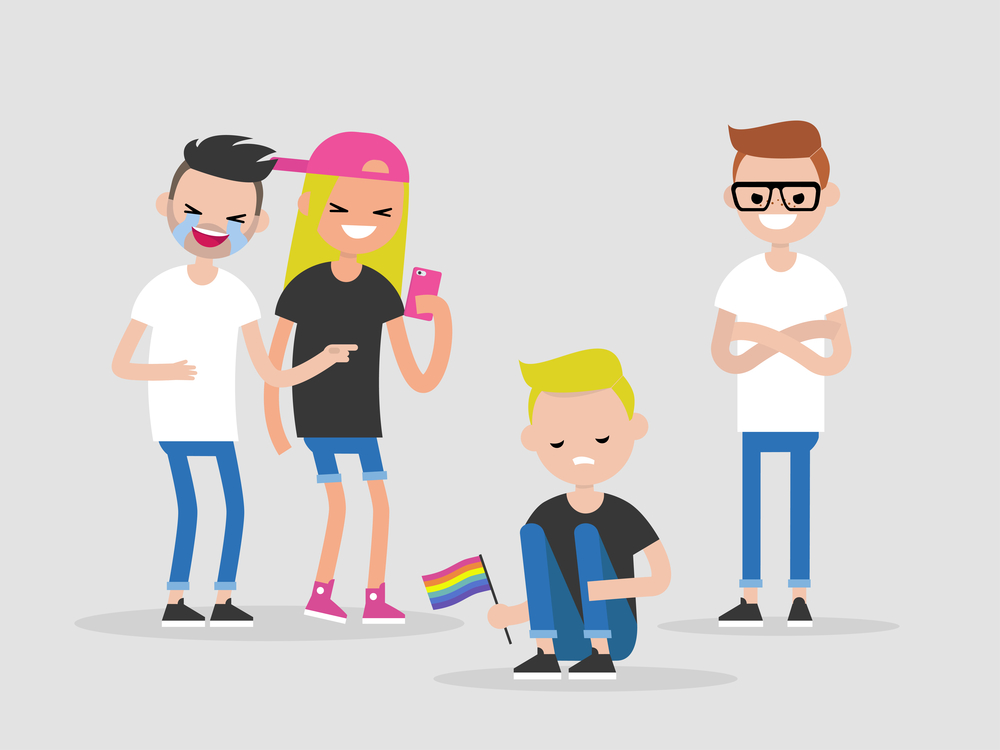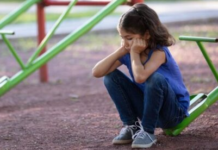October is the National Bullying Prevention Month. Research demonstrates that bullying can compromise mental health. As a result, the United Nations has called for policies to address bullying as part of a rights-based approach to mental health.
A recent article published in the JAMA Pediatrics explores whether anti-discrimination litigation is related to sexual orientation-based harassment and discrimination in schools. The study found that litigation that protects and promotes LGBT+ rights may reduce rates of homophobic bullying in schools.
The study was led by Dr. Mark L. Hatzenbuehler, a professor from the department of psychology at Harvard University. Hatzenbuehler and his coauthors write:
“Homophobic bullying – a subtype of bias-based bullying – has been linked to significantly worse psychosocial and academic outcomes. While there is emerging evidence that litigation can change the public attitude toward stigmatized groups, the extent to which litigation affects stigmatizing behaviors remains largely untested.”
 Research suggests both bullies and victims of bullying experience increased risk for symptoms associated with psychiatric disorders. Sexual minority youths are especially vulnerable to bias-based bullying, which leads to more psychological distress and an increased suicide rate. Nevertheless, school-based bullying prevention programs often overlook homophobic bullying.
Research suggests both bullies and victims of bullying experience increased risk for symptoms associated with psychiatric disorders. Sexual minority youths are especially vulnerable to bias-based bullying, which leads to more psychological distress and an increased suicide rate. Nevertheless, school-based bullying prevention programs often overlook homophobic bullying.
“Because existing approaches either lack empirical evidence or encounter significant obstacles, we focus on litigation as an alternative strategy for reducing homophobic bullying,” the researchers write. “We examined whether litigation was associated with reductions in homophobic bullying measured within the same school during the case and after it was resolved.”
Due to the lack of existing data, this study designed a unique method to combine information on the outcomes of multiple court cases with individual-level data on stigmatizing behaviors in a real-world setting. The study coded effects of litigation addressing alleged violations of the rights of students who are (or are perceived to be) lesbian, gay, bisexual, or transgender (LGBT) under laws prohibiting harassment or discrimination in California schools after 2000 and linked the outcomes to survey data on homophonic bullying from over 1.5 million youth across 499 schools in California.
They identified 31 unique court cases and coded students as being enrolled into three different types of schools: the case schools (the schools that were the subject of litigation), the spillover schools (a school in the district that was the subject of litigation but not the school itself), and the control schools (a school that was neither the subject of litigation nor in the same district as the case schools).
The study first controlled for all student demographic information (e.g., age, sex, race, and ethnicity), schools’ total enrollment, and the presence of Gender and Sexualities Alliances (GSA), the analysis compared before-and-after changes in the probability of homophobic bullying among students in schools subject to litigation with control schools.
The results showed a noticeable reduction in rates of homophobic bullying in case schools, although the finding was not statistically significant.
They also found that the type and outcome of the litigation led to different results in case schools:
“In districts where the plaintiff secured monetary and/injunctive relief, students in spillover schools experienced a 24% reduction in the ROR of homophobic bullying the years after the case resolution.”
“For students in case schools vs. control schools where the defendant (school or district) avoided adverse legal consequences, there was a nonsignificant 10% reduction in the odds ratios of homophobic bullying in the years during the case; however, this association was reversed in the years after the case resolution, where students experienced a nonsignificant 27% increase in the odds ratios of homophobic bullying.”
Recognizing homophobic bullying as a public health concern, the study revealed that antidiscrimination litigation could be a strategy to address the bias-based bullying of LGBT youth. The study also encouraged future research to examine any specific aspects of litigation most strongly associated with changes in the outcome to propose effective ways to combat inequalities experienced by LGBT youth.
The authors conclude:
“With the effect sizes comparable with that of resource-intensive school-based bullying interventions, litigation seeking to address alleged violations of the rights of students who are (or perceived to be) lesbian, gay, bisexual, or transgender under laws prohibiting harassment or discrimination may lead to reductions in rates of homophobic bullying… Homophobic bullying slightly increased in the school and district where the defendant (school) avoided adverse legal consequences.”
****
Hatzenbuehler, M. L., McKetta, S., Kim, R., Leung, S., Prins, S. J., & Russell, S. T. (2022). Evaluating litigation as a structural strategy for addressing bias-based bullying among youth. JAMA pediatrics, 176(1), 52-58. (Link)















In my land a six year old child has just gotten into serious trouble with the law for “hate speech”. A six year old! The legal system.
I think there was a time just prior to the breakout of revolution where the Christain church went obsessive on logical analysis, to the point where scholars of that time debated for ages over how many angels can dance on the pinnacle of a pin. This is what an over emphasis on logic brings humans to, they get swept up into a vortex of logic that goes around in circular arguments and eats its own tail and from the perspective of a caveman begins to feel a bit unwise not wise.
To have a healthy use of logic requires that logic be balanced by gut feelings, this combination arrives at common sense.
Children are creatures who live in the “feelings accepting” here and now and seldom think five minutes ahead into the consequences of their speech. At my school other children were called smelly or poop or pissy pants or cry baby. Was that bullying? For some it was, for others it was jokey insolence or one up manship. If you watch a litter of kittens they are often pouncing on each other, practicing being grown up lions. Is that “phobia”?
It says in the Declaration of Human Rights that we are all entitled to “hold our own opinion”. I think having an opinion can be fed by our own feelings, something we also have a right to feel, since opinions and feelings are not outward behaviour. So I think it is not the end of the world if someone feels phobic fear so long as they never come out with any bullying bad behaviour. You cannot force love. Not without being a bully. Lots of people have phobias. There are millions of ways people fear each other without such fear ever becoming outbursts of numb cruelty. Chasing people and telling them they must not feel fear probably escalates tension.
I am not sure of what I am saying here but just that children have been doing “being children” for centuries without outside interference from logical legal systems.
That said I do think no trans child should be bullied.
NO child should be bullied.
Logic always wants to do the job of love that love can do better.
Any child is given to off the cuff moments of hissy fit hatred. Any child is a babbler of speech. Thus a child can come out with both of these combined in the moment of sticking out a tongue.
I am against bullying.
Which also means that you cannot bully someone to love you. To force love out of someone is the soonest way to destroy what little love there is.
Bullying is outward bad behaviour. How a person feels within is really an interior free choice. Feelings are not hurtful unless thoughts turn the person to outward physical acts of violence or abuse.
NO child should be treated with violence or abuse or intolerance.
Report comment
I’m nonbinary trans and queer, and I’m horrified that any child—ESPECIALLY a child under seven, whose little brain is still in early stages of developing their capacity for empathy—would be punished under hate speech laws. That is so incredibly wrong.
My mom is a retired elementary school teacher whose favourite grades to teach were primary/kindergarten and first grade. I know from her that kids that age really aren’t capable of “hate speech”. That’s absurd. They can parrot things they’ve heard. They can have strong emotional reactions that they don’t have words to explain. They can express genuine confusion or curiosity. Of course, they are too young to have learned to filter themselves, much less choose their words carefully. Any of these things may lead to them saying something that can hurt another child’s feelings. Punishing them for not having the capacity to understand or empathize like an adult is not appropriate or okay.
That poor child ought to have been gently taught why what they said might hurt someone’s feelings and helped to apologize and make up with the child whose feelings they hurt. Not told they committed and act of “hate speech”. If I were that child, I would be afraid to express my thoughts and feelings after the adults around me overreacted so extremely to something I said. That’s so unhealthy for all children. Frankly, I think adults accusing a child of six of “hate speech” is abusive.
And for goodness’ sake: my niece said some things around that age that made me concerned they were learning transphobic views from media they watched and people they encountered in the world (as I knew they weren’t learning it at home). I needn’t have: as you can tell from my use of singular “they” for them, they currently prefer to use neutral pronouns. As do many of their friends. What a child thinks and expresses at six can have little to no relationship with what they think, how they feel and their values even a handful of years down the line. My niece has also always been supportive of my nephew, who enjoyed playing with makeup and dresses sometimes when he was very little. I’m so glad I never said anything to her or her parents about the couple times I heard her say things that made me uncomfortable when she was very little. They amounted to nothing and I couldn’t live with myself if I’d scared her into silencing herself. I’m very thankful I trusted my instinct to say nothing and let her grow up to be wonderful self. I had no right to project my adult anxieties onto her.
Children are so malleable and so fundamentally built to accept and love. To punish a child for saying words they may not even fully understand is a crime on par with telling a gender nonconforming child there’s something wrong with them for not fitting expected stereotypes.
You’re so right. No child should ever be bullied. Especially not by adults.
Thank you for your thoughtful comment. I hope that poor six-year-old has not been badly traumatized.
Report comment
[Duplicate Comment]
Report comment